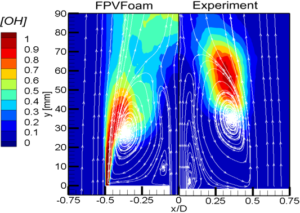
As part of the development of a numerical framework to study soot formation in turbulent combustion processes, a flamelet progress variable (FPV) combustion model is utilized here to perform numerical simulations of turbulent reacting flows. More specifically, a non-premixed turbulent flame of methane-air stabilized in a semi-infinite bluff-body burner is numerically studied using OpenFOAM. The selected axisymmetric configuration consists of a central jet of CH4 in a cylindrical bluff-body and an outer coflowing-air stream. The interaction between chemical reactions and turbulence is described with the FPV combustion model and finite-rate chemistry effects are accounted for through the detailed chemical kinetic mechanism GRI-MECH 3.0. The flamelet library is built up in the pre-processing step using a laminar counterflow diffusion flame configuration, following specific criteria carefully chosen so as to properly describe several flame conditions ranging from long enough flow residence times to flame extinction limits. All numerical simulations are performed in a large eddy simulation (LES) based context. For the LES studies, the wall-adapting local eddy-viscosity (WALE) model is used as subgrid-scale one. Numerical results are compared with an experimental data set including velocity field and OH radical fluorescence obtained by joint particle image velocimetry (PIV) and planar laser induced fluorescence (PLIF). The comparisons between the obtained numerical results and the corresponding experimental data include mean fields of velocity, Reynolds stress tensors, turbulent kinetic energy and normalized OH. Overall, a relatively good agreement between numerical predictions and experimental results was observed. Both the double vortex structure and the recirculation zone length were in particular well predicted. In addition, Reynolds stresses and turbulent kinetic energy predictions agree relatively well with the experiment. However, predicted normalized OH radical profiles presented significantly discrepancies when compared to the experiments due to the lifted nature of the measured flame was not well predicted.
Autor(es):MANRIQUE, Javier
CELIS, Cesar
FIGUEIRA DA SILVA, Luis Fernando
Año: 2021
Título de la revista: 26th ABCM International Congress of Mechanical Engineering
Ciudad: Virtual, Online
Url: https://hal.archives-ouvertes.fr/hal-03322357/
